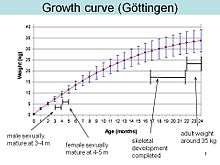Göttingen minipig
Göttingen Minipig (also known as the Göttinger or Goettingen Minipig) is a breed of miniature swine developed specifically for use in biomedical research. The Göttingen Minipig is a member of the species Sus scrofa domestica along with other domesticated swine. The Göttingen Minipig is best known for its exceptionally small size and its very clean and well-characterized health status. Development of this breed began in the late 1960s at the Institute of Animal Breeding and Genetics (Institut fϋr Tierzucht und Haustiergenetik) at the University of Göttingen, Germany, by crossbreeding the Minnesota minipig, the Vietnamese Potbelly Pig and the German Landrace pig.[1] Today the Göttingen Minipig is bred at four separate locations globally and is used in life-saving biomedical research all over the world.[2]

History
For centuries, the pig has been considered a suitable animal model in medical research due to its many similarities with human anatomy. Early assumptions about human anatomy were possible due to parallels drawn between human and pig anatomy. The famous anatomist Galen of Pergamon (A.D. 129–201) dissected pigs and other species to develop an understanding of human anatomy. For centuries his work was the foundation for a basic understanding of human anatomy. Today we know that there are anatomical and physiological differences between pigs and humans. As with all species, however, the many similarities that do exist make pigs an incredibly valuable model for the study of both human and animal disease.[3]
The use of pigs in biomedical research has increased since the 1940s. Several strains of miniature pigs (also known as minipigs) have been developed for research purposes. Smaller pigs require less space and diet, are easier to handle and require a lesser amount of the compound being tested.[4]
The Göttingen Minipig was the first minipig breed to be developed in Europe. It was available to the German biomedical research community from the late 1960s. Breeding began by crossing the Minnesota minipig, obtained from the Hormel Institute in the United States, and the Vietnamese potbelly pig, obtained from a German zoo. Subsequent cross breeding with the German Landrace produced the white or pink skin pigmentation which characterizes modern Göttingen Minipigs. Breeding goals included a low body weight, good ear veins, and low in-breeding coefficients.[1]
In 1992, the first colony of barrier-bred, microbiologically-defined Göttingen Minipigs was derived in Denmark. From this colony, Göttingen Minipigs were provided for biomedical research performed throughout Europe and to a limited extent in North America. Beginning in 2003, a colony of Göttingen Minipigs was established in the United States. Since 2010 the breed has also been available for use in Japan.[2] Global use of Göttingen Minipigs has been increasing over the past two decades.
Göttingen Minipigs are also known for their microbiologically-defined health status. Most Göttingen Minipigs are bred and raised in a barrier breeding facility under strict biosecurity procedures. The benefits of microbiological standardization of the colony’s health status include a reduction in background pathology, limited threat of secondary infections, limited contamination of biological products and increased safety for technical staff. Health monitoring is performed in all Göttingen Minipig colonies following the recommendations provided by the Federation of European Laboratory Animal Sciences Associations,[5] and health monitoring reports can be obtained from the breeding facilities for each colony.[2]
Behaviour

Like all pigs, minipigs are social animals. Both in the wild and in the laboratory, pigs will develop a complex social hierarchy. This hierarchy centres on food and begins at birth with the teat order. New groups will have to establish a hierarchy upon being introduced, which can involve displays of aggressive or sexual behaviour. Usually groups stabilize within 24 to 28 hours after being introduced. When possible, minipigs are housed in groups in the laboratory. It is important that each minipig has visual, audial, and olfactory contact with other pigs. In the wild, the pig is an animal of prey and until trust has been established, pigs may seem cautious of caretakers. Pigs are very curious of their surroundings, and a variety of toys and enrichment devices are used with laboratory pigs to encourage their sense of play and their desire to explore and learn.[6]
Biomedical Research
A European network of experts in biomedical, veterinary and animal welfare professions collaborated to develop the Rethink Report. This is a comprehensive evaluation of the role minipigs play in the future of medical research and pharmaceutical discovery. The use of the minipig as model in biomedical research has been increasing and, while every model has its limitations, the minipig provides significant advantages for the biomedical community.[7]
References
- 1 2 Bollen, PJA & Ellegaard, L.(1996). Developments in Breeding Göttingen Minipigs. In Tumbleson & Schook (eds.) Advances in Swine in Biomedical Research. New York: Plenum Press
- 1 2 3 http://www.minipigs.dk
- ↑ Swindle, M. (2007). Swine in the Laboratory: Surgery, Anesthesia, Imaging, and Experimental Techniques. Boca Raton: CRC Press
- ↑ McAnulty, PA, Dayan, AD, Ganderup, NC, & Hastings, KL. (2012). The Minipig in Biomedical Research. Boca Raton: CRC Press
- ↑ http://www.felasa.eu/recommendations/recommendation/recommendations-for-health-monitoring-of-cats-dogs-and-pigs
- ↑ American Association of Laboratory Animal Science. (2012). Techniques Training: Minipig. Memphis: McNeal Graphics
- ↑ http://www.rethink-eu.dk